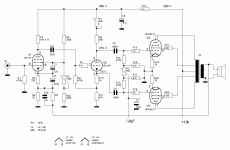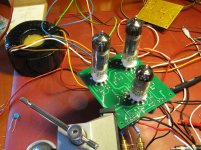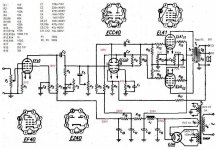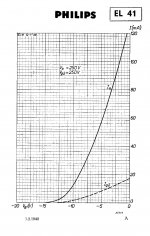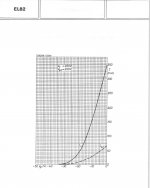Hi
I have 75-100 pieces EL 82 / PL 82 tubes. They may then be used for anything other than taking place.
The Philips data sheet mentions 12W, Va = 200, Vg = 200, Raa = 4k in pp configuration.
Since I have so many, a 4 tubes amp is an option.
Are there any who have tried this tube?
Regards
Benny
I have 75-100 pieces EL 82 / PL 82 tubes. They may then be used for anything other than taking place.
The Philips data sheet mentions 12W, Va = 200, Vg = 200, Raa = 4k in pp configuration.
Since I have so many, a 4 tubes amp is an option.
Are there any who have tried this tube?
Regards
Benny
Are there any who have tried this tube?
I have built and tested several amplifiers with EL86 (6P43P-E), which is quite close to EL82.
With 300 V supply voltage and 5k UL-output transformer, more than 20 W is possible to get. With 250 V and 4k UL-OPT, it is possible to have some 15 W.
This is my test circuit, a Dynaco-style pentode amplifier/cathodyne phase inverter with 6F12P triode pentode.
Attachments
A two pair or even four pair per channel push pull would be a fun build with these.
Sounds like The Stupendous 6P1P 4PP amplifier!
I have built and tested several amplifiers with EL86 (6P43P-E), which is quite close to EL82.
With 300 V supply voltage and 5k UL-output transformer, more than 20 W is possible to get. With 250 V and 4k UL-OPT, it is possible to have some 15 W.
This is my test circuit, a Dynaco-style pentode amplifier/cathodyne phase inverter with 6F12P triode pentode.
Hi artosalo,
where did you find the nice PCB?
regards
Peter
check out this URL's (amps with PL82):
Hoechst Empfindlich
https://www.audionist.de/2016/03/20/konstruktion-eines-roehrenverstaerkers-mit-pl82-dritter-teil/
https://www.audionist.de/2016/04/28/praktischer-aufbau-meiner-endstufe-mit-pl82/
Endstufe mit PL 82 - aus dem Buch Höchst Empfindlich, von Götz Wilimzig / Rüdy Gysemberg
Hoechst Empfindlich
https://www.audionist.de/2016/03/20/konstruktion-eines-roehrenverstaerkers-mit-pl82-dritter-teil/
https://www.audionist.de/2016/04/28/praktischer-aufbau-meiner-endstufe-mit-pl82/
Endstufe mit PL 82 - aus dem Buch Höchst Empfindlich, von Götz Wilimzig / Rüdy Gysemberg
Attached a schematic with a pair of EL82's in triode mode and with cathode feedback.
I don't know why the cathodes sit at 272 V (and because of that the anode voltage sits at 465 V). Only because of the available power transformer? Or is there more to it?
Except for tube base and filament requirements, the UL41 is practically the same tube as the EL82/PL82. Maybe this gives you a bit more to choose from.
I don't know why the cathodes sit at 272 V (and because of that the anode voltage sits at 465 V). Only because of the available power transformer? Or is there more to it?
Except for tube base and filament requirements, the UL41 is practically the same tube as the EL82/PL82. Maybe this gives you a bit more to choose from.
Attachments
In contrary to what has been said previously, EL82 and PL82 aren't 12 watts pentodes, but 9 watts instead, see also the Philips datasheet excerpt at the Japanese site. EL86 is a 12 watts pentode.
As especially PL82's still are cheap enough, I wouldn't bother with expensive UL41's as replacements, which indeed is equivalent electrically.
Best regards!
As especially PL82's still are cheap enough, I wouldn't bother with expensive UL41's as replacements, which indeed is equivalent electrically.
Best regards!
EL82 is a nice medium steep tube, it can be used with CFB, if you have the transformers. I'm using a CFB SE with an EL84, which is slightly higher in steepness and I see no reason you can't do the same with PP. Or you could employ plate to grid feedback. Many options. Check Patrick Turner's (RIP) pages, they could give you some ideas.
Yes, it's like the difference between EL84 and PL84/UL84. The series heated tubes have lower plate resistances and lower µg2g1, enabling them to operate at lower mains/supply voltages satisfyingly.
I have a Philips 52HD514a table radio, unfortunately incomplete with missing back cardboard panel and dial cord, that also features two EL41's in PP (and rimlock tubes throughout).
Best regards!
I have a Philips 52HD514a table radio, unfortunately incomplete with missing back cardboard panel and dial cord, that also features two EL41's in PP (and rimlock tubes throughout).
Best regards!
The Philips EL5000 16 mm Professional Sound Film System has 4 x UL41 in push-pull with cathode feedback: Amplifiers with valves
This is an interesting device, especially due to the HF generator that feeds the projection lamp! Anyway, it is more than questionable why Philips opted for UL41's and fed their heaters directly from the power tranny's primary instead of EL41's and safe 6.3 Vac heater windings.
We're still missing a hint to the primary impedance of a UL41 PP amplifier.
Best regards!
Edit: The hint relly isn't that far: The UL41 datasheet mentiones 4 kohms as the primary impedance in PP amplifiers operating either at 100 and 170 V.
We're still missing a hint to the primary impedance of a UL41 PP amplifier.
Best regards!
Edit: The hint relly isn't that far: The UL41 datasheet mentiones 4 kohms as the primary impedance in PP amplifiers operating either at 100 and 170 V.
Last edited:
- Home
- Amplifiers
- Tubes / Valves
- EL82 - PL82 PP amplifier
